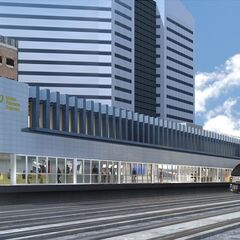AnarchoSocialist
Active Member
If a people mover option is picked, then they should scrap LINK and do it properly, picking something like the PRT system at Heathrow. Connections should be dead simple....no escalators or stairs or elevators....just pods waiting on the other side of the platform as soon as you get off the train. If you can just off a train, grab a pod (with no wait or at least minimal wait during busy periods) and head straight to your terminal in a very short time, then it might be a reasonable option. Not what I would prefer but at least it would be a huge improvement over the two cheapo options currently on the table.
There are some benefits to this plan if implemented properly. Metrolinx could still run small train sets specifically designed to serve Union-Pearson to ensure that there is frequent (at least every 15 minute service) until the line is converted from diesel bi-levels to an electrified regional rail line. Once that change over happens, the only thing being scrapped is the rolling stock, and even then it could be put to use elsewhere on the GO network. If designed properly the station could be made to feel as though its a part of the airport itself. Dont call it Malton or Woodbine (whichever one happens to be used)...call it Lester B. Pearson. Make it modern and comfortable and attractive just like the airport itself. If you cant create the illusion that once they have gotten off the train they are basically already at the airport, then that would make the plan successful. I would also note that this would require PRT (no monorail or cable cars or anything like that) as PRT would allow for the perfect way to manage the shuttling of passengers to and from the station and terminal (a simple example would be sending pods to whatever platform is about to receive a train to make sure there are enough waiting for disembarking passengers).
There are some benefits to this plan if implemented properly. Metrolinx could still run small train sets specifically designed to serve Union-Pearson to ensure that there is frequent (at least every 15 minute service) until the line is converted from diesel bi-levels to an electrified regional rail line. Once that change over happens, the only thing being scrapped is the rolling stock, and even then it could be put to use elsewhere on the GO network. If designed properly the station could be made to feel as though its a part of the airport itself. Dont call it Malton or Woodbine (whichever one happens to be used)...call it Lester B. Pearson. Make it modern and comfortable and attractive just like the airport itself. If you cant create the illusion that once they have gotten off the train they are basically already at the airport, then that would make the plan successful. I would also note that this would require PRT (no monorail or cable cars or anything like that) as PRT would allow for the perfect way to manage the shuttling of passengers to and from the station and terminal (a simple example would be sending pods to whatever platform is about to receive a train to make sure there are enough waiting for disembarking passengers).
Last edited:







